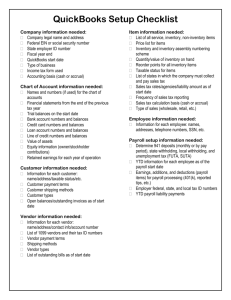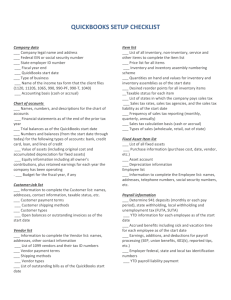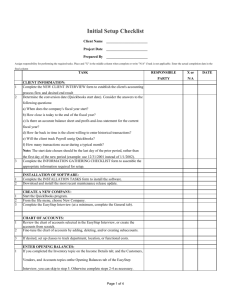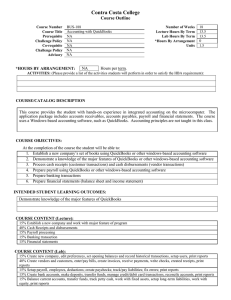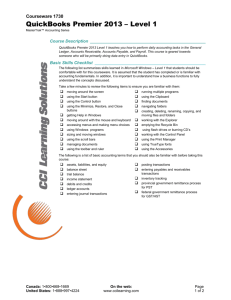Information checklist for client set up Carmen F. Calabrese PH.D
advertisement
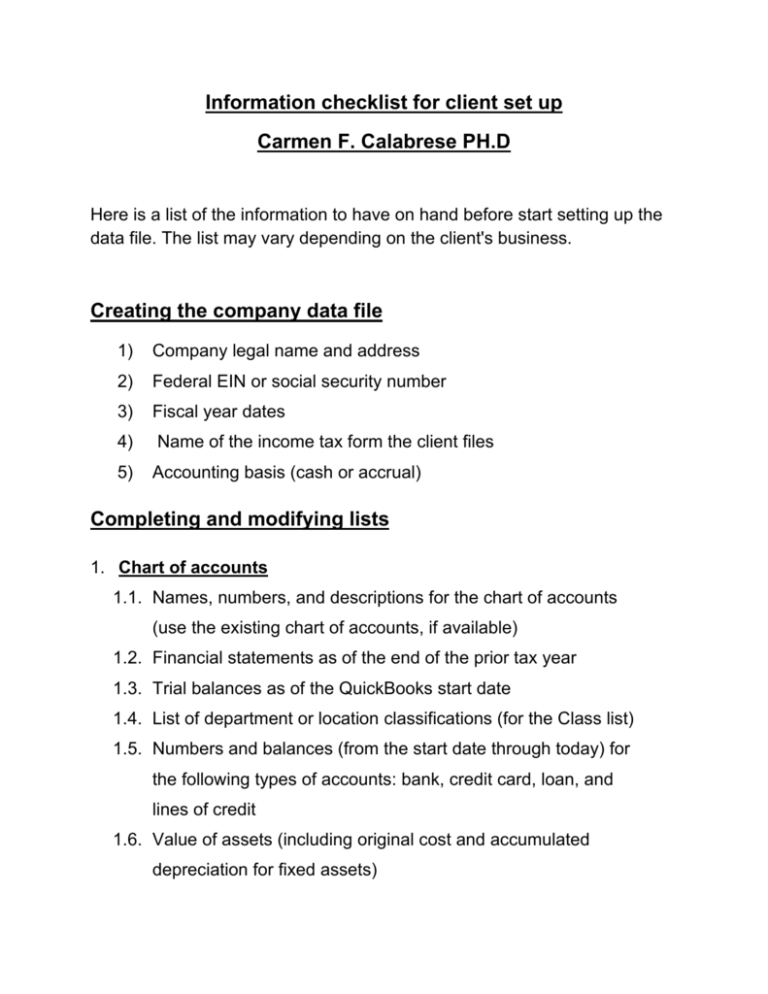
Information checklist for client set up Carmen F. Calabrese PH.D Here is a list of the information to have on hand before start setting up the data file. The list may vary depending on the client's business. Creating the company data file 1) Company legal name and address 2) Federal EIN or social security number 3) Fiscal year dates 4) Name of the income tax form the client files 5) Accounting basis (cash or accrual) Completing and modifying lists 1. Chart of accounts 1.1. Names, numbers, and descriptions for the chart of accounts (use the existing chart of accounts, if available) 1.2. Financial statements as of the end of the prior tax year 1.3. Trial balances as of the QuickBooks start date 1.4. List of department or location classifications (for the Class list) 1.5. Numbers and balances (from the start date through today) for the following types of accounts: bank, credit card, loan, and lines of credit 1.6. Value of assets (including original cost and accumulated depreciation for fixed assets) 1.7. Equity information including all owner's contributions, plus retained earnings for each year the company has been operating 2. Customers & Jobs list 2.1. Customer numbering scheme 2.2. Information to complete the Customer list names, addresses, contact information, taxable status, etc. 2.3. Customer payment terms 2.4. Customer shipping methods 2.5. Customer types 2.6. Open balances or outstanding invoices as of the start date 3. Vendor List 3.1. Vendor numbering scheme 3.2. Information to complete the Vendor list: names, addresses, other contact information 3.3. List of 1099 vendors and their tax ID numbers 3.4. Vendor payment terms 3.5. Shipping methods 3.6. Vendor types 3.7. List of outstanding bills as of the QuickBooks start date 4. Item list 4.1. List of all inventory, non-inventory, service, and other items to complete the Item list 4.2. Price list for all items 4.3. Inventory numbering scheme 4.4. Quantities on hand and values for inventory as of the start date 4.5. Desired reorder points for all inventory items 4.6. Taxable status for each item 4.7. List of states in which the company pays sales tax 4.8. Sales tax rates, sales tax agencies, and the sales tax liability as of the start date 4.9. Frequency of sales tax reporting (monthly, quarterly, annually) 4.10.Sales tax calculation basis (cash or accrual) 4.11.Type of sales (wholesale, retail, out of state) 4.12.Manufacturer's part numbers for client's vendors 5. Fixed Asset Item list 5.1. Asset name 5.2. Account used to track the asset 5.3. Purchase date, cost, and vendor 5.4. Description, location, and warranty information 6. Employee list 6.1. Employee numbering scheme 6.2. Information to complete the Employee list: names, addresses, telephone numbers, social security numbers, etc. 7. Setting up payroll: Determine the following 7.1. 941 Deposits: 7.1.1. Monthly 7.1.2. Each pay-period 7.2. State Withholding: 7.2.1. Monthly 7.2.2. Quarterly 7.2.3. Annually 7.2.4. Multi-state (Specify: __________________) 7.3. Local Withholding: 7.3.1. Monthly 7.3.2. Quarterly 7.3.3. Annually 7.4. Unemployment Tax: 7.4.1. FUTA 7.4.2. SUTA (Rate:__________________) 7.5. Assemble the following: 7.5.1. YTD information for each employee as of the start date 7.5.2. Accrued benefits including sick and vacation time for each employee as of the start date 7.5.3. Earnings, additions, and deductions for payroll processing (SEP, union benefits, 401 (k), reported tips, etc. 7.5.4. Employer federal, state, and local tax identification numbers 7.5.5. YTD payroll liability payments 8. Entering historical transactions 8.1. Accounts receivable transactions 8.2. Accounts payable transactions 8.3. Historical payroll transactions 8.4. Bank and other transactions
